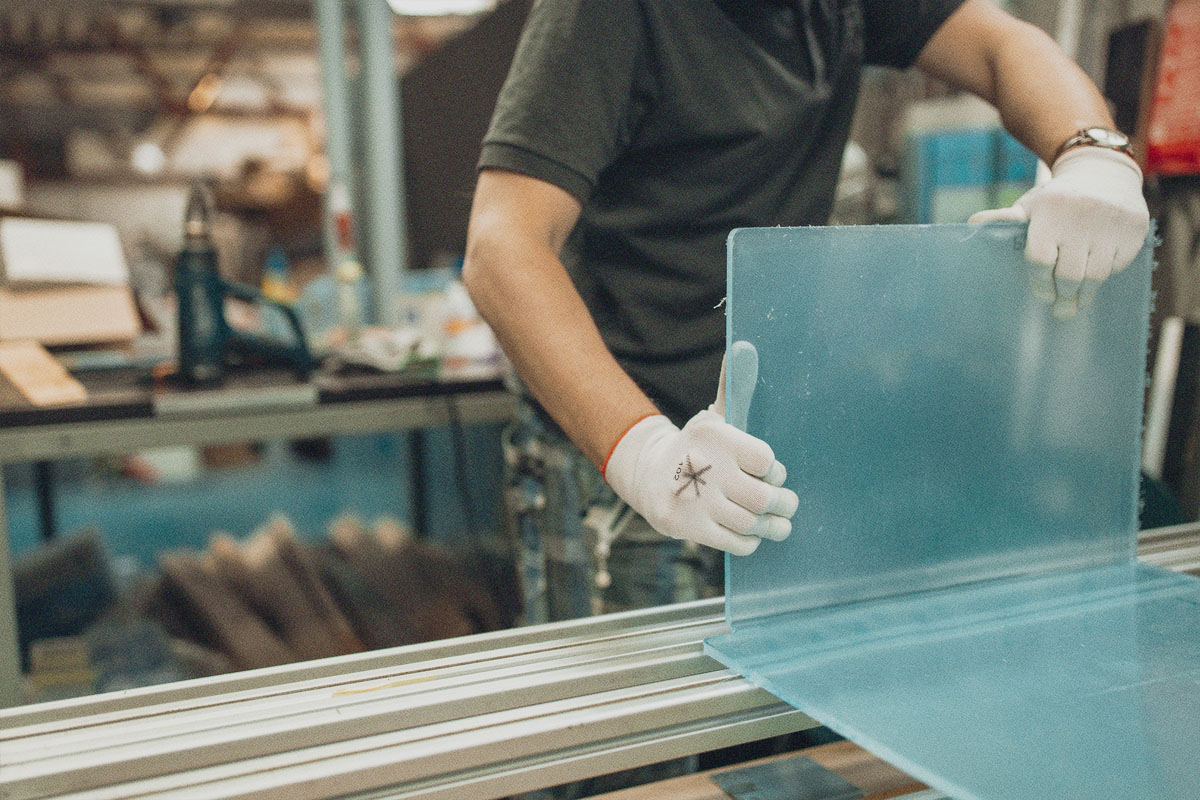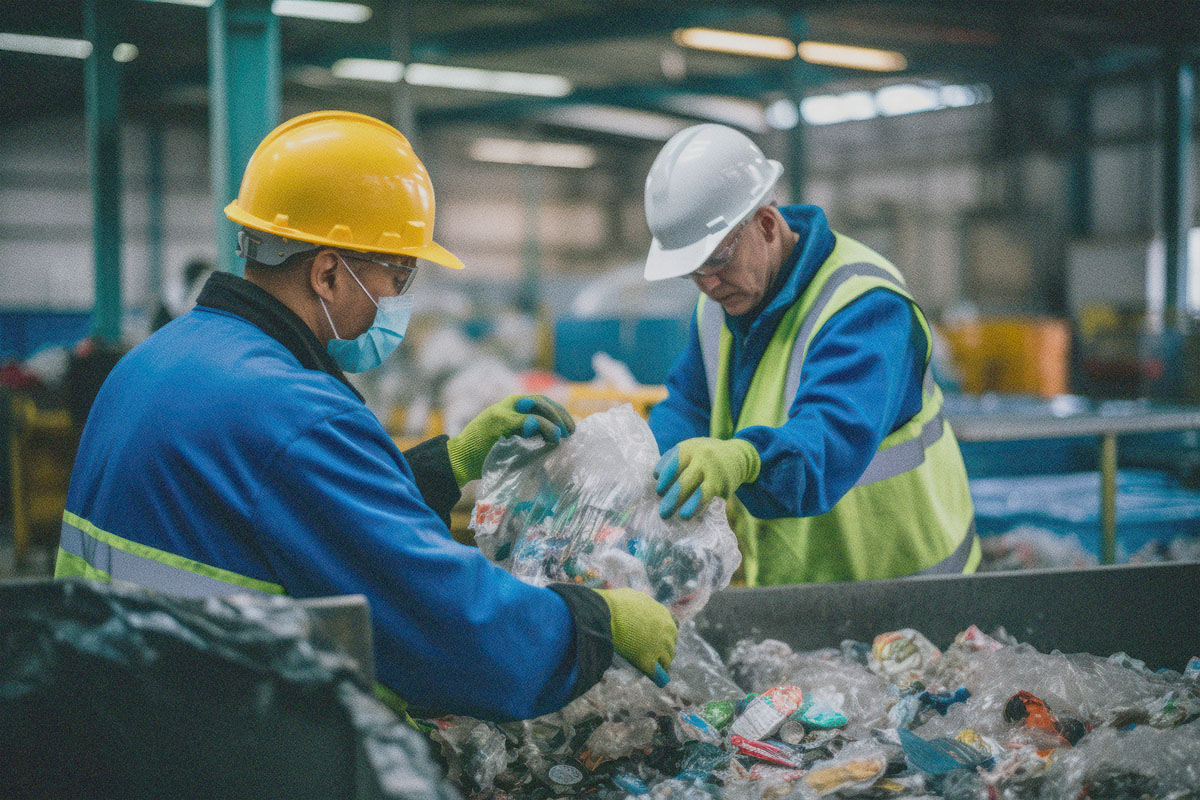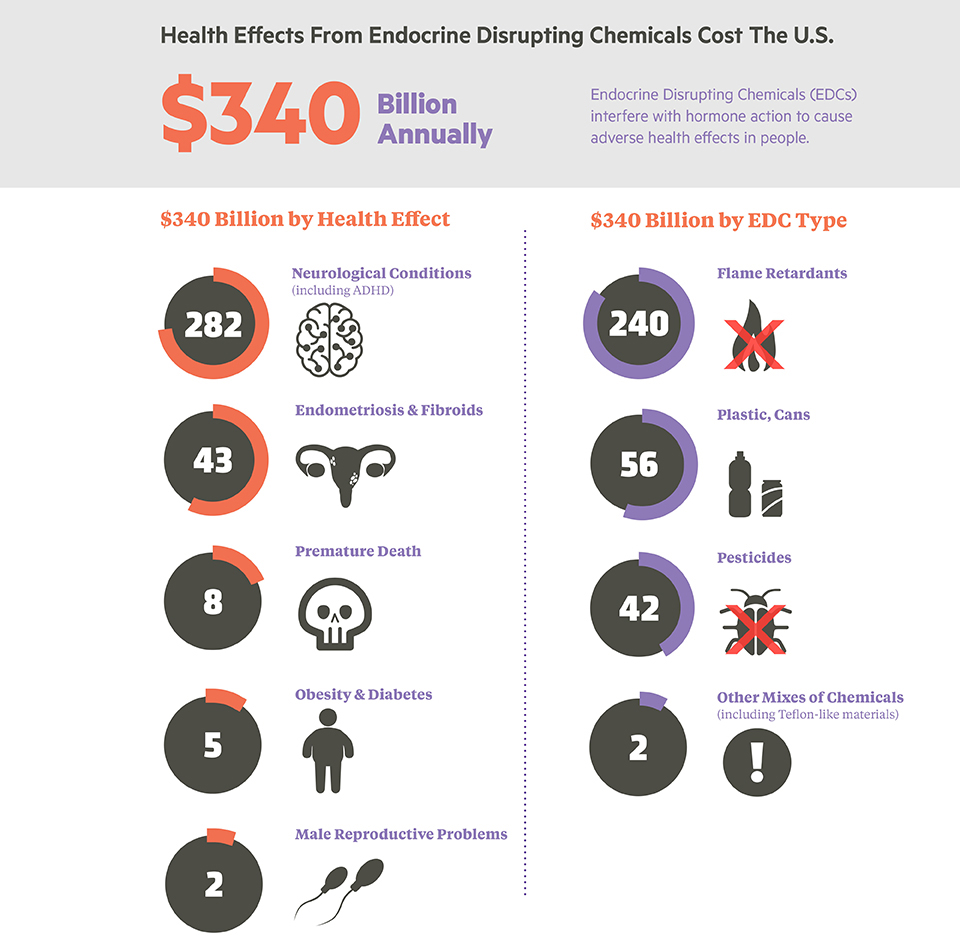 NEW REPORT
NEW REPORT
This fact sheet highlights the building and construction sector’s significant contributions to global plastic pollution.
Using case studies of flooring products specified in the K-12, healthcare, and affordable housing sectors, the fact sheet introduces opportunities for building practitioners to reduce the plastic footprint of their buildings and emphasizes the impact that one building can make by specifying low/no-plastic products.

NBC’s Cynthia McFadden interviews an expert from Toxic Free Future about their recent report revealing that over 36 million pounds of vinyl chloride are transported daily on more than 200 rail cars, highlighting the risks similar to those seen in the East Palestine train derailment.

This report discusses concerns about replacing lead service lines with PVC plastic pipes, highlighting the potential health and environmental risks associated with leaching chemicals, urging for thorough consideration and evaluation of alternative piping materials.
We have been picking on plastics a lot recently (see articles: Addressing the Plastic Crisis: Why Vinyl Has to Go and The Illusion of Plastic Recycling: Neither Just Nor Circular). This is because we believe that typically the best way to avoid hazardous chemicals is to avoid plastic altogether. With this said, we recognize plastics in buildings are currently ubiquitous (see article: Our Plastic Buildings: A New Driver of Fossil Fuel Demand).
So, let’s consider what would need to happen for plastic building products to be considered truly sustainable. Can the plastics industry do better? What are the key opportunities today to do so, and what global policy tools could promote these opportunities? These are among the key questions HBN explored in the development of a pair of case studies for the international Organization for Economic Co-operation and Development (OECD) as part of the Inter-Organization Programme for the Sound Management of Chemicals (IOMC).
Before we jump into the case study findings, first, let’s define plastics. For the purposes of this article, we define plastics to be any polymeric material, fossil fuel based or bio-based. The case studies focused on durable plastic goods, using building materials as an example.
The case studies explored both plastic flooring and plastic insulation with the goal of increasing awareness of environmental and human health impacts of plastic product production at each stage of the lifecycle and proposing policy interventions that can help move the industry toward more sustainable plastics products in general.

What would be defined as a sustainable plastic?
In the report, we created a framework for evaluating what a truly sustainable plastic product would look like. These goals are lofty, and currently no existing plastic building materials meet these goals. However, they provide a pathway towards truly sustainable products.
To be considered a sustainable plastic, a product would have to enhance human and environmental health and safety across the entire product life cycle. It would have to be managed within a sustainable materials management system, and would have to meet the following goals:
- Must be inherently low hazard.
- Hazardous substances are eliminated.
- Transparency in terms of content and emissions exists at every step of the supply chain.
- Full hazard assessments are available on all chemicals.
- Must have a confirmed commercial afterlife.
- Products designed for durability, reclamation, reuse, and recycling.
- Infrastructure exists to support reclamation, reuse, and recycling.
- Materials can undergo multiple cycles of recycling.
- Must generate no waste.
- Manufacturing scrap is eliminated at every step of the production process.
- Scrap from installation is eliminated.
- Must use rapidly renewable resources or waste-derived materials.
Trade-offs examples
The case study explores trade-offs that exist between different material choices.
For a flooring example, a product that is designed to use adhesive to install is typically thinner than one that uses a click tile system to install. These thinner products use less material per square foot and therefore have less chemical impacts associated with manufacturing and less waste at the end of life. However, adhesives may add hazardous substances to the product installation stage. By moving from a click tile product to a glue down product, chemical exposure burdens shift from manufacturing and end of life to the installation stage and use phase.
For an insulation example, a product that is designed to chemically react at the build site, such as spray polyurethane foam (SPF), can allow the insulation to form an air-sealed custom fit. However, SPF is not recyclable, and adherence of that insulation to surrounding materials may also make those materials more difficult to reclaim or recycle. Moving from XPS, EPS or polyiso to SPF may reduce the ability of other surrounding materials to “have a commercial afterlife” in the pursuit of an added performance feature.

Building awareness around these trade-offs enables stakeholders to make informed choices.
Back to reality
Now, back to reality after crafting the characteristics of a theoretical sustainable plastic. The bottom line is that there are no sustainable plastics that exist today, and we are a long way off from that day. Today, project teams need to prioritize which sustainability goals are most important and how to deal with real and significant gaps in understanding and/or data.
The case studies compared only product types made of plastic, but in reality, project teams have a wider variety of materials to choose from in any given product category. HBN’s Product Guidance considers the most commonly used product types within a product category and ranks those product types relative to one another from a chemical hazard perspective. Product types made of plant-based materials or minerals tend to rank higher than plastic products. You can apply the same sustainability goals proposed in this article to non-plastic products.
In project design, the biggest leaps towards more sustainable products from a chemicals perspective often requires consideration of vastly different materials versus making incremental improvements in chemistry for a particular product type. For example, this could mean moving from vinyl to linoleum flooring versus attempting to select the least bad vinyl option.
Check out the full flooring and insulation case studies for examples of how to use these goals to consider and choose the variety of plastic product types you will inevitably be specifying for your next project. Alternatively, challenge yourself to skip the plastics whenever possible. Even selecting one non-plastic product is cause for celebration. Make the swap!

Health Care Without Harm Europe advocates for the complete elimination of PVC due to its environmental impact, urging policymakers to develop a strategy for its phase-out in Europe.
If we are to have any chance of addressing the global plastics crisis, Polyvinyl Chloride plastic (PVC) also known as vinyl, has got to go.
It cannot be produced sustainably or equitably. It cannot be “optimized.” It cannot be recycled. It will never find a place in a circular economy, and it makes it harder to achieve circularity with other materials, including other plastics.
There are three reasons for this: technical, economic, and behavioral. The inherent qualities of PVC and its cousin, CPVC, make it among the most technologically challenging plastics to recycle. Like most plastics, PVC is made with fossil fuel feedstocks. Unlike other plastics, PVC/vinyl also contains substantial amounts of chlorine, upwards of 40%. This is the C in PVC, and this chlorine content adds an additional layer of negative impacts to the earth and its people, social inequity, and an impediment to recycling that cannot be overcome. Recyclers consider it a contaminant to other plastic feedstock streams.1 It mucks up the machines and the already perilous economics of plastics recycling.

There is an emerging global consensus on this point, albeit euphemistically stated. The Ellen MacArthur New Plastics Economy Project consists of representatives from the world’s largest plastic makers and users, along with governments, academics, and NGOs. In 2017 it reached the conclusion that PVC was an “uncommon” plastic that was unlikely to be recycled and should be avoided in favor of other more recyclable packaging materials.2 “Uncommon” in the diplomatic parlance of international multistakeholder initiatives means unrecyclable. The project also took note of the many toxic emissions associated with PVC production.
That’s not surprising since after 30 years of hollow promises and pilot projects doomed to fail, virtually no post-consumer PVC is recycled.3 Conversely, leading brands with forward-looking materials policies such such as Nike, Apple, and Google have prioritized PVC phase outs.4
But in the building industry, PVC rages on. Virgin vinyl LVT flooring is the fastest growing product in the flooring sector. So much so that in 2017 sustainability leader Interface introduced a new product line of virgin vinyl LVT, despite forecasting just one year before that by 2020 the company would “source 95 percent of its materials from recycled or biobased resources.”5
The current flooring market demands the impossible – aesthetic qualities and durability at a price unmatchable by non-vinyl floor coverings. A price that is unmatchable because at every stage of vinyl production, the societal costs of its poisonous environmental health consequences are externalized, subsidized, paid for by the people who live in communities that have become virtual poster children for environmental injustice and oppression. Places like Mossville, LA; Freeport, TX; and the Xinjiang Province in China, home to the oppressed Uighur population. As we detail in our exhaustive Chlorine and Building Materials report, the unique chlorine component of PVC plastic contributes to a range of toxic pollution problems starting with the fact that chlorine production relies upon either mercury-, asbestos-, or PFAS-based processes. This is in addition to the onerous environmental health burdens of petrochemical processing that burden all plastics.
It is true that all plastics contribute to environmental injustices. Virtually all plastics are made from fossil fuel feedstocks, and all plastics share abysmally low recovery and cycling rates. Still, independent experts agree that some plastics are worse than others, and PVC is among the worst.6 Additionally, most uses of PVC have readily available alternatives or solutions that are within reach. Certainly there are non-PVC alternatives for flooring. What can’t be beat is the cost – that is, the low purchase price at the point of sale, subsidized by the sacrifices we ignore in the communities where the plastics are manufactured and the waste is dealt with. And BIPOC communities bear the disproportionate burden of it all. Acknowledging and addressing this tradeoff is at the root of the behavioral change that stands between us and a just and healthy circular economy.
In his influential book How To Be An Antiracist, Dr. Ibram X. Kendi argues that if we recognize we live in a society with many racial inequities – and acknowledge that since no racial group is inferior or superior to another, the cause of these inequities are policies and practices – then to be anti-racist is to challenge those policies and practices where we can and create new ones that create equity and justice for all.
Imagine if as part of our commitment to equity in our sustainability efforts, we recognized, acknowledged, and did what we could to address the racial inequities associated with PVC production, and committed right now to stop using PVC unless it was absolutely essential. The plastics industry would howl and point out inconsistencies, question priorities, highlight unintended consequences. We would all feel a tinge of whataboutism – what about carbon, or this other injustice, or that shortcoming of the alternatives. But it is clear that widespread incrementalism is failing us on so many fronts, none more than the environmental injustices that are hardwired into our supply chains.
In fact, there are many examples of companies and building projects that have prioritized PVC-free alternatives based upon principles of equity and justice. We need more leaders in the field to join those who are abandoning vinyl in product types that have superior options. Our CEO Gina Ciganik used a non-PVC flooring in 2015 at The Rose, her last development project prior to joining HBN.
First Community Housing, another affordable housing leader, has been using linoleum for many years for similar reasons. In their Leigh Avenue Apartments project. Forbo’s Marmoleum Click tiles were the flooring of choice.
Vinyl is not an essential material for any of the largest surface areas of our building projects – flooring, wall coverings, or roofing. It may often be the conventional choice in conventional buildings, but it should not be the conventional choice in buildings that promise to be green, healthy, and equitable. LVT may be the fastest growing flooring product in the world, but it is a throwback to the inequitable, unsustainable world we say is unacceptable, not the world we are trying to create.

Habitable can help you start by using our Informed™ product guidance, which helps identify worst and best in class products that are healthier for people and the planet. So why not start here and now, with a principled stand of refusing to profit from unjust, frequently racist, externalized costs?
SOURCES
- https://plasticsrecycling.org/pvc-design-guidance
- See pp. 27-29: www.newplasticseconomy.org/assets/doc/New-Plastics-Economy_Catalysing-Action_13-1-17.pdf
- See e.g. Figure 1: https://css.umich.edu/publication/plastics-us-toward-material-flow-characterization-production-markets-and-end-life
- See e.g.: www.apple.com/environment/answers (Apple); www.greenpeace.org/usa/reports/greener-electronics-2017 (Google); www.latimes.com/archives/la-xpm-1998-aug-26-fi-16540-story.html (Nike)
- www.greenbiz.com/article/inside-interfaces-bold-new-mission-achieve-climate-take-back: “Going Beyond Zero” The march towards Mission Zero continued unabated, however, with consistent year-over-year improvement in most metrics. Today, the company forecasts that by 2020 it will halve its energy use, power 87 percent of its operations with renewable energy, cut water intake by 90 percent, reduce greenhouse gas emissions 95 percent (and its overall carbon footprint by 80 percent), send nothing to landfills, and source 95 percent of its materials from recycled or biobased resources.
- www.cleanproduction.org/resources/entry/plastics-scorecard-press-release
“When I came here, my unit was on the brink of falling apart. We had so many problems; the carpets were incredibly old, and turning the AC on was like having a helicopter inside the house.”
These are the words of Vanessa del Campo. She was born and raised in Mexico and like many other people, she moved to the United States searching for safer and better living conditions. She now lives in Minnesota and rents a small unit in a multifamily apartment building located in one of the areas designated by the Minnesota Pollution Control Agency (MPCA) as of Environmental Justice concern. Her experience as a tenant is filled with stories of unjust evictions, health concerns, and constant battles with unlawful landlords that neglected her right to even the most basic human living conditions.
Fortunately for Vanessa and other neighbors in her building, she received support from a community-based organization, Renters United for Justice (abbreviated IX from its name in Spanish), that helped them organize and mobilize to reclaim desperately needed services to maintain their health and wellbeing. What began as an organized effort to request new windows for a handful of apartment units turned into an exhausting but successful journey to purchase the run-down complex of apartment buildings from their landlord and secure a loan to renovate all the apartments.

It’s easy to get lost in Vanessa’s excitement as she talks about this newfound opportunity. She mentioned that her baby had a tough time learning to crawl because it was too dangerous to place her on the ground due to rats and cockroaches often running past her. At the same time, it is also easy to forget that in addition to being a mother and having a demanding job, she now has to fulfill the role of a building co-owner as a leading member of the newly formed residents’ collective (A Sky Without Limits).
With so much work going into buying and renovating the apartment complex, the residents had little time to think about the chemical safety of their chosen building materials. That’s where HBN came in. In 2021 the MPCA awarded IX and Healthy Building Network a grant to work together to reduce toxic chemical exposures among children, pregnant individuals, employees, and communities who are disproportionately impacted by harmful chemicals used in common products.
One example of toxic chemicals in homes are phthalates, or orthophthalates, which are chemicals that help make plastics flexible. They can also impact the proper development of children. These chemicals are banned in children’s toys in the U.S., and The Minnesota Department of Health in partnership with MPCA named phthalates as “Priority Chemicals” as part of the 2017 Toxic-Free Kids Act. While many manufacturers have phased out hazardous phthalate plasticizers, existing vinyl flooring, especially those installed 2015 and earlier, likely contain these potential developmental toxicants. This translates to dozens of pounds of these hazardous chemicals in the floor of a single apartment unit. As these chemicals are released from products, they deposit in dust, which can be inhaled or ingested by residents – particularly young children who are crawling on floors and often place their hands in their mouths.
“Honestly, we never stopped to think about how harmful [building] materials could be.” Vanessa said. “It was just regrettable to see how we were living. We understand that the new materials that are going into our buildings today may not be the healthiest. Today, we realize it is important to think about how we want to live in our homes, to imagine the quality of life we want in our buildings, in our community.”
Over the coming year, HBN will work with IX and the residents’ collective to evaluate the materials used in their ongoing renovation process and provide recommendations to improve material selection. We will also develop resources tailored to residents to enhance their understanding of how the surrounding environment influences their health. To extend the impact of this work, we will create and share a set of best practices that property managers and tenant organizations can use to advocate for healthier materials in the communities they live in and properties they manage.
“Our collaboration with HBN is timely. By working together with the property managers, we can raise their awareness about how their work impacts our health and help change how they select materials,” Vanessa said.
At Healthy Building Network, we are grateful for the opportunity to work with IX and local leaders like Vanessa through the MPCA grant that makes this collaboration possible. We call on public agencies, foundations, and private investors to fund initiatives that seek to dismantle health inequities through direct investment in the communities disproportionately impacted by environmental injustice, especially related to toxic chemical exposures. We look forward to sharing with you the lessons, stories, and resources that come out of this collaboration.

To learn more about selecting healthier products, visit our Informed™ website, which includes a wide range of resources and tools to help you find healthier material options.
Un inquilino clama por viviendas más seguras y saludables
“Cuando llegué aquí, mi apartamento estaba a punto de desmoronarse. Tuvimos muchos problemas; las alfombras eran increíblemente viejas y encender el aire acondicionado era como tener un helicóptero dentro de la casa”. Estas son las palabras de Vanessa del Campo.
Vanessa nació y creció en México, y como muchas otras personas, se mudó a los Estados Unidos en busca de mejores condiciones de vida. Ahora vive en Minnesota y alquila un apartamento en un edificio multifamiliar ubicado en una de las áreas designadas por la Agencia de Control de Contaminación de Minnesota (MPCA) como de interés de Justicia Ambiental. Su experiencia como inquilina está marcada con historias de desalojos injustos, preocupaciones de salud, y batallas constantes con propietarios que negaron su derecho a incluso las condiciones más básicas de vida.
Afortunadamente para Vanessa y otros vecinos en su edificio, ella recibió el apoyo de Inquilinos Unidos por Justicia (IX), una organización comunitaria que les ayudó a organizarse y movilizarse para recuperar los servicios que desesperadamente necesitaban para mantener su salud y bienestar. Lo que comenzó como un esfuerzo organizado para solicitar nuevas ventanas para un pequeño número de apartamentos, se convirtió en una larga pero exitosa tarea para comprar el destartalado complejo de apartamentos y asegurar un préstamo para renovar todas sus unidades.
“Pasamos por muchos litigios con el propietario porque no estaba haciendo las reparaciones que necesitábamos y no quería vendernos los edificios. El año pasado, cuando llegó la pandemia, finalmente obtuvimos la oportunidad de comprar el edificio. Fue un momento feliz y difícil porque estábamos aterrorizados de enfermarnos [con el virus], pero logramos organizarnos y apoyarnos unos a otros. Hoy estamos trabajando con una nueva empresa de administración de propiedades y el banco para instalar alfombras, pisos, techos, ventanas, hornos, refrigeradores y baños nuevos. Estamos haciendo una profunda renovación para llevar todos los apartamentos a un estado que es mucho, mucho mejor que el que teníamos”.
Es fácil dejarse llevar por la emoción de Vanessa mientras habla de esta nueva oportunidad. Ella mencionó que su bebé tuvo dificultades para aprender a gatear porque era demasiado peligroso colocarle en el suelo debido a las ratas y cucarachas que a menudo rondaban la casa. Al mismo tiempo, también es fácil olvidar que además de ser madre y tener un trabajo exigente, ahora tiene que cumplir el rol de copropietaria de un edificio como miembro principal de un recién formado colectivo de residentes (Un Cielo Sin Límites).
Con tanto trabajo invertido en la compra y renovación del complejo de apartamentos, los residentes tuvieron poco tiempo para pensar en la seguridad química de los materiales de construcción que fueron utilizados en sus apartamentos. Ahí es donde entra Healthy Building Network (HBN, o, La Red de Edificios Saludables). A principios de este año, MPCA otorgó a IX y HBN una subvención para reducir la exposición a sustancias químicas tóxicas entre los niños, las personas embarazadas, los empleados y las comunidades que se ven afectadas de manera desproporcionada por sustancias químicas nocivas utilizadas en productos comunes.
Un ejemplo de sustancias químicas tóxicas en los hogares son los ftalatos u ortoftalatos, que son sustancias químicas utilizadas para ayudar a dar flexibilizar a los plásticos. Estas sustancias también pueden afectar el desarrollo adecuado de los niños. Estos productos químicos están prohibidos en los juguetes de los niños en los EE. UU. El Departamento de Salud de Minnesota, en asociación con MPCA, nombró a los ftalatos como “productos químicos prioritarios” como parte de la Ley de Niños Libres de Tóxicos de 2017. Si bien muchos fabricantes han eliminado los plastificantes de ftalato, estos químicos están presentes en los pisos de vinilo existentes, especialmente los instalados antes de 2016. Esto se traduce en docenas de libras de estos químicos peligrosos en el piso de una sola unidad de apartamento. A medida que estos productos químicos se liberan de los productos, se depositan en el polvo que los residentes pueden inhalar o ingerir, afectando especialmente a los niños pequeños que gatean por el suelo y a menudo se llevan las manos a la boca.
“Honestamente, nunca nos detuvimos a pensar en lo dañino que podrían ser los materiales [de construcción]”. Dijo Vanessa. “Fue lamentable ver cómo vivíamos. Entendemos que los materiales que se utilizan en nuestros edificios hoy en día pueden no ser los más saludables. Hoy nos damos cuenta de que es importante pensar en cómo queremos vivir en nuestros hogares, imaginar la calidad de vida que queremos en nuestros edificios, en nuestra comunidad”.
Durante el próximo año, HBN trabajará con IX y el colectivo de residentes para evaluar los materiales utilizados en su proceso de renovación y brindar recomendaciones para mejorar la selección de materiales. También desarrollaremos recursos para ayudar a los residentes a entender cómo el entorno circundante influye en su salud. Para extender el impacto de este trabajo, crearemos y compartiremos un conjunto de mejores prácticas para que los administradores de propiedades y las organizaciones de inquilinos puedan abogar por utilizar materiales más saludables en las comunidades en las que viven y en las propiedades que administran.
“Nuestra colaboración con HBN es oportuna. Al trabajar junto con los administradores de propiedades, podemos aumentar su conciencia sobre cómo su trabajo impacta nuestra salud y ayudar a cambiar la forma en que seleccionan los materiales”, dijo Vanessa.
En Healthy Building Network, estamos agradecidos por la oportunidad de trabajar con IX y líderes locales como Vanessa a través de la subvención otorgada por MPCA que hace posible esta colaboración. Hacemos un llamado a las agencias públicas, fundaciones e inversionistas privados para que financien iniciativas que busquen desmantelar las inequidades en salud a través de inversión en las comunidades impactadas de manera desproporcionada por la injusticia ambiental, especialmente relacionada con la exposición a sustancias químicas tóxicas. Esperamos pronto poder compartir con ustedes las lecciones, historias y recursos que surgen de esta colaboración.
Have you ever seen a building product advertise that it contains recycled content and wondered what that material actually was and where it came from? We certainly have. Many building products advertise recycled content, but most often the identity and chemical makeup of the recycled material are not shared.
Using products that contain recycled content can be a great way to reduce environmental impacts and support a circular economy by keeping still-useful materials out of landfills and avoiding the impacts of manufacturing virgin materials. Unfortunately, some recycled materials contain toxic chemicals that come along for the ride when incorporated into new products. For example, 2015 testing of a range of vinyl floors found high levels of toxic lead and cadmium from recycled content in the inner layers of the floors.1
Defining recycled content
Recycled content is broadly broken down into pre-consumer and post-consumer materials. As defined by the U.S. Green Building Council2 :
- Post-consumer material is “waste material generated by households or by commercial, industrial, and institutional facilities in their role as end-users of the product, which can no longer be used for its intended purpose.” Some examples of post-consumer recycled material include glass bottles or vehicle tires.
- Pre-consumer material is “material diverted from the waste stream during the manufacturing process.” This definition excludes reuse of scrap materials back into the same process. Some examples of pre-consumer recycled material include treated waste from coal fired power plants (such as fly ash used in carpets or FGD gypsum used in drywall) or waste wood fiber from a sawmill used in composite wood like medium density fiberboard (MDF).

Ensuring safer recycled materials
While some recycled feedstocks, such as sawdust and glass containers, can be safely recycled into new products, others contain legacy contaminants that can lead to toxic exposures when used in new products. To address the potential for toxic re-exposures from recycled materials, HBN worked with green building standards such as LEED and Enterprise Green Communities to include credits that consider not just if a product contains recycled content, but also what that content is and if it has been screened for potential hazards.
Enterprise Green Communities Criterion 6.2, Recycled Content and Ingredient Transparency, acknowledges that the need for content transparency applies to recycled content as well as virgin materials. It calls for using products that contain post-consumer recycled content where the origin of the recycled content is publicly disclosed along with information on how the recycled content is screened for or otherwise avoids heavy metals.
Mind the data gap
Product manufacturers may not always have detailed content information available for the recycled materials they use. Supply chain tracking and internal screening requirements can help manufacturers ensure that the recycled materials they incorporate into new products don’t bring along hazardous contaminants.
Building a Sustainable Future
Removing toxic chemicals from new products makes a commercial afterlife possible, supports a safe and circular economy, and minimizes negative human health impacts. Using materials that are recoverable at the end of their life and building infrastructure to reuse or recycle them will lessen future impacts. Fully and transparently documenting product contents now also supports future recycling by identifying materials that may later be determined to be toxic.
As a building material specifier, the next time you consider a product with recycled content, make sure to ask the manufacturer for full transparency of product content, including where that recycled content came from.

Together we can reduce human exposure and work towards a safe and circular economy.
SOURCES
- Vallette, Jim. “Post-Consumer Polyvinyl Chloride in Building Products.” Healthy Building Network, 2015. https://habitablefuture.org/wp-content/uploads/2024/03/90-post-consumer-polyvinyl-chloride-pvc-report.pdf.
- USGBC. “Building Product Disclosure and Optimization – Material Ingredients.” U.S. Green Building Council. Accessed January 27, 2021. https://www.usgbc.org/credits/new-construction-core-and-shell-schools-new-construction-retail-new-construction-healthca-24.

Phase 2 of this report is the first of its kind plant-by-plant accounting of the production, use, and releases of chlorine and related pollution around the world. It is intended to inform the efforts of building product manufacturers to reduce pollution in their supply chains.
Chlorine is a key feedstock for a wide range of chemicals and consumer products, and the major ingredient of polyvinyl chloride (PVC) plastic. The report includes details aboutthe production technologies used and markets served by 146 chlor-alkali plants (60 in Asia) and which of these plants supply chlorine to 113 PVC plants (52 in Asia). The report answers fundamental questions like:
- Who is producing chlorine?
- Who is producing PVC?
- Where? How much? And with what technologies?
- What products use the chlorine made in each plant?
Key findings include:
- Over half of the world’s chlorine is consumed in the production of PVC. In China, we estimate that 74 percent of chlorine is used to make PVC.
- 94 percent of plants in Asia covered in this report use PFAS-coated membrane technology to generate chlorine.
- In Asia the PVC industry has traded one form of mercury use for another. While use of mercury cell in chlorine production is declining, the use of mercury catalysts in PVC production via the acetylene route is on the rise. 63 percent of PVC plants in Asia use the acetylene route.
- 100 percent of the PVC supply chain depends upon at least one form of toxic technology. These include mercury cells, diaphragms coated with asbestos, or membranes coated with per- and polyfluoroalkyl substances (PFAS), used in chlorine production. In PVC production, especially in China, toxic technologies include the use of mercury catalysts.
Supplemental Documents:
For years, Habitable has been thinking about and consulting with our partners about how to describe the impact of choosing healthier building products. Here’s why this is a complex and challenging issue for the industry:
- Incomplete knowledge of what many building products are made of
- Limited understanding of the health hazards of the thousands of chemicals in commerce today
- Trade-offs when making material choices
These reasons drive the need for full transparency of chemical contents and full assessment of chemical hazards. This can ultimately lead to optimizing products in order to avoid hazardous chemicals.
Toxic chemicals have a huge and complex impact on the health and well-being of people and the environment. Those impacts are spread throughout a product’s life cycle. For example, fenceline communities can be exposed during the manufacturing of products in adjacent facilities, workers can be exposed on the job during the manufacturing and installation processes, and building occupants can be exposed during the product’s use stage. Some individuals suffer multiple exposures because they are affected in all of those instances.
In addition, toxic chemicals can be released when materials are disposed of or recycled. When they incorporate recycled content into new products, manufacturers can include legacy toxicants, inhibiting the circular economy and exposing individuals to hazardous chemicals—even those that have been phased out as intentional content in products.
We know intrinsically that hazardous chemicals have the potential to do harm and that they commonly do so. For champions of this cause, that understanding of the precautionary principle is enough. Others still need to be convinced and often want to quantify the impact of a healthy materials program. How can healthy building champions start to talk about and quantify the impacts of material choices?


Broad Impacts of Toxic Chemicals
One way researchers quantify the impact of chemicals is to consider the broad economic impacts of chemical exposures. Evidence increasingly shows that toxic chemical exposures may be costing the USA billions of dollars and millions of IQ points. One recent study estimates that certain endocrine-disrupting chemicals cost the United States $340 billion each year. This is a staggerring 2.3% of the US gross domestic product.1 And that is for only a subset of the hazardous chemicals that surround us every day. These numbers provide important context for the larger discussion of toxic chemical use, but cannot easily be tied to daily decisions about specific materials.
Market Scale Impacts
For years, Habitable has been targeting orthophthalates in vinyl flooring as a key chemical and product category combination to be avoided. Orthophthalates can be released from products and deposited in dust which can be inhaled or ingested by residents—particularly young children who crawl on floors and often place their hands in their mouths3. By systematically reducing chemicals of concern in common products, we can all work together to continue to affect this scale of change in the marketplace and keep millions more tons of hazardous chemicals out of buildings.
Impacts on the Project Scale
Context is key for understanding the impact chemical reduction or elimination can have—a pound of one chemical may not have the same level of impact as a pound of another chemical. But, given the right context, this sort of calculation may prove useful as part of a larger story. The following examples provide context for the story of different impacts of different chemicals.
- Small decisions, big impacts: While many manufacturers and retailers have phased out hazardous orthophthalate plasticizers, some vinyl flooring may still contain them. If we consider an example affordable housing project, avoiding orthophthalates in flooring can keep dozens of pounds of these hazardous chemicals out of a single unit (about the equivalent of 10 gallons of milk).4 For a whole building, this equates to several tons of orthophthalates that can be avoided.5 It is easy to see how this impact quickly magnifies in the context of a broader market shift.
- Little things matter: Alkylphenol ethoxylates (APEs) in paints are endocrine-disrupting chemicals make up less than one percent of a typical paint. In this case, by making the choice to avoid APEs, a couple of pounds of these hazardous chemicals are kept out of a single unit (about the equivalent of a quart of milk). This translates to a couple of hundred pounds kept out of an entire building.6 This quantity may seem small compared to the tons avoided in the phthalate example above, but little things matter. Small exposures to chemicals can have big impacts, particularly for developing children.7 And, since our environments can contain many hazardous chemicals, and we aren’t exposed to just a single chemical at a time, these exposures stack up in our bodies.8
- Reducing exposure everywhere: Choosing products without hazardous target chemicals keeps them out of buildings, but can also reduce exposures as these products are manufactured, installed, and disposed of or recycled. Some chemicals may have impacts that occur primarily outside of the residence where they are installed, but these impacts can still be significant. Polyvinyl chloride (PVC), for example, a primary component of vinyl flooring, requires toxic processes for its production and can generate toxic pollution when it is disposed of. Manufacturing of the PVC needed to create the vinyl flooring for one building as described above can release dozens of pounds of hazardous chlorinated emissions, impacting air quality in surrounding communities.9 These fenceline communities are often low-income, and suffer from disproportionate exposure in their homes, through their work, and from local air pollution. If choosing non-vinyl flooring for a single building can help reduce potential exposure to hazardous chlorinated emissions in these fenceline communities, imagine the potential impacts of avoiding vinyl on a larger scale!
In addition to information about target chemicals to avoid, our Informed™ product guidance provides recommendations of alternative types of materials that are typically better from a health hazard perspective and includes steps to work toward the goal of full transparency of product content and full assessment of chemical hazards. This framework can help ensure that toxic chemicals and regrettable substitutions are avoided.
Each decision you make about the materials you use, each step toward using healthier products, can have big impacts within a housing unit, a building, and in the broader environment. Collectively, these individual decisions also influence manufacturers to provide better, more transparent products for us all. Ultimately, this can reduce the hazardous chemicals not just in our buildings but also in our bodies.
SOURCES
- Attina, Teresa M, Russ Hauser, Sheela Sathyanaraya, Patricia A Hunt, Jean-Pierre Bourguignon, John Peterson Myers, Joseph DiGangi, R Thomas Zoeller, and Leonardo Trasande. “Exposure to Endocrine-Disrupting Chemicals in the USA: A Population-Based Disease Burden and Cost Analysis.” The Lancet 4, no. 12 (December 1, 2016): 996–1003. https://doi.org/10.1016/S2213-8587(16)30275-3.
- “Disease Burden & Costs Due to Endocrine-Disrupting Chemicals.” NYU Langone Health, July 12, 2019. https://med.nyu.edu/departments-institutes/pediatrics/divisions/environmental-pediatrics/research/policy-initiatives/disease-burden-costs-endocrine-disrupting-chemicals.
- Bi, Chenyang, Juan P. Maestre, LiG Hongwan, GeR Zhang, Raheleh Givehchi, Alireza Mahdavi, Kerry A. Kinney, Jeffery Siegel, Sharon D. Horner, and Ying Xu. “Phthalates and Organophosphates in Settled Dust and HVAC Filter Dust of U.S. Low-Income Homes: Association with Season, Building Characteristics, and Childhood Asthma.” Environment International 121 (December 2018): 916–30. https://doi.org/10.1016/j.envint.2018.09.013.; Mitro, Susanna D., Robin E. Dodson, Veena Singla, Gary Adamkiewicz, Angelo F. Elmi, Monica K. Tilly, and Ami R. Zota. “Consumer Product Chemicals in Indoor Dust: A Quantitative Meta-Analysis of U.S. Studies.” Environmental Science & Technology 50, no. 19 (October 4, 2016): 10661–72. https://doi.org/10.1021/acs.est.6b02023.
- According to the USDA, milk typically weighs about 8.6 pounds per gallon. See: “Weights, Measures, and Conversion Factors for Agricultural Commodities and Their Products.” United States Department of Agriculture, June 1992. https://www.ers.usda.gov/webdocs/publications/41880/33132_ah697_002.pdf?v=0.
- HBN used the Common Products for Luxury Vinyl Tile and Vinyl Sheet to estimate the amount of plasticizer. We assumed a 100 unit building of 1000 square foot two-bedroom apartments with vinyl flooring throughout the units.
- HBN used the Common Product profiles for Eggshell and Flat Paint to estimate the amount of surfactant and assumed a 100 unit building of 1000 square foot two-bedroom apartments.
- Vandenberg, Laura N., Theo Colborn, Tyrone B. Hayes, Jerrold J. Heindel, David R. Jacobs, Duk-Hee Lee, Toshi Shioda, et al. “Hormones and Endocrine-Disrupting Chemicals: Low-Dose Effects and Nonmonotonic Dose Responses.” Endocrine Reviews 33, no. 3 (June 1, 2012): 378–455. https://doi.org/10.1210/er.2011-1050.
- Impacts can be additive, where health impacts are equal to the sum of the effect of each chemical alone. They can also be synergistic, where the resulting health impacts are greater than the sum of the individual chemicals’ expected impacts.
- HBN used the Common Products for Luxury Vinyl Tile and Vinyl Sheet to estimate the amount of PVC. We assumed a 100 unit building of 1000 square foot two-bedroom apartments with vinyl flooring throughout the units. Emissions are based on the Calvert City, KY Westlake plant examined in HBN’s Chlorine and Building Materials Project. According to EPA’s EJScreen tool, the census blockgroup where this facility is located is primarily low income, with 62% of the population considered low income (putting this census block group in the 88th percentile nationwide in terms of low income population). EJScreen, EPA’s Environmental Justice Screening and Mapping Tool (Version 2018). Accessed March 18, 2019. https://ejscreen.epa.gov/mapper/.

 Pollution
Pollution Health
Health Equity
Equity